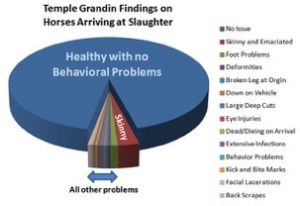
By Nick D’Agostino
Horse racing…… the sport of kings, the glitz, the glamour and all the pomp and circumstance you can handle. I never really gave much thought initially to all the behind the scenes issues that exist in horse racing when I first started out. On the outside it seems so regal and classy, but beneath the esthetics there’s another side. The one nobody wants to talk about in the industry. Horse Slaughter-
The issue of horse slaughter is as broad and vast as a wildfire raging through dry brush. The topic is equally hot if you bring it up to anyone in the business. Ask anyone in the business what they think of horse slaughter and most of them want to run for the exit because it’s so politically charged that one wrong word in the wrong direction could have ripple effects on future business amongst a host of other unknown ramifications.
Thoroughbred horse slaughter is a direct result of over breeding and the claiming portion of racing. This is a multi state matter, however the current issues in Louisiana have been talked about recently on social media and it seems to draw the ire of people on multiple sides of the isle.
Louisiana is a large state with 4 race tracks and has a horse slaughter problem that is deplorable and downright inhumane to say the least. Delta and Evangeline Downs which are operated by Boyd Gaming is known for having horses that raced at their tracks magically showing up to kill lots in droves. One recently sent had just raced 2 days prior and showed up in a kill lot.
Some horses that can no longer compete in racing have either been sent to compete in back woods bush racing or they end up on the slaughter pipeline. It is Illegal to slaughter horses in the United States since 2007 but it’s ok to send them over to Mexico or Canada and allow them to do the dirty work. Boyd Gaming had initially come up with their version of a solution by revoking stall rights for any trainers or owners that were found to have sent a horse to a kill lot. The easy fix to that is circumventing the system. If the horse isn’t shipped directly from the track to the kill lot then you are in compliance.
The Kill Lot
Based on data that I have found courtesy of Equine Welfare Alliance in 2017 there were over 20,198 horses sent to slaughter through Mexico and Canada. Thus far this year and data only compiled through April we are already at 22,024 and counting. The staggering numbers of horses being slaughtered is not a recent issue. This has been going on for a very long time. A study done by www.wildlifefoundation.org back in 2012 found that between 2004-2010 the amount of horses slaughtered was equal to 70% of the annual thoroughbred foal crop.
Kill lots act as a middle man with the slaughter houses located in Canada and Mexico. They post pictures and video’s of these horses on social media for sale at inflated prices tugging at the heart strings of people like Dina Albarano from IcareIhelp. These kill lots like Thompson’s Horse Lot & Co have previously been found to be in violation of the inhumane treatment of animals, not following USDA protocol’s and basically having little to no proper documentation. Could this be to mask where horses they are receiving are coming from? Why are the tattoos being burned off or obscured? There are only two logical reasons I can see; to shut down the paper trail of where these horses came from and to protect the identity of who brought these horses to them. If there is another reason I am missing, please share it.
Dina has been vastly criticized on numerous occasions because she has raised money through crowd sourcing funds to save these horses from an ugly fate. The kill lots inflate prices to animal lovers/ OTTB advocates like Dina because they know that the last thing she would want is any of those horses being shipped off to a cruel fate. Dina and people just like her have critics on separate platforms.
There are others that oppose Dina Alborano and her methods and view her actions as though paying the “ransom” on the horses in the kill lots only further empowers the kill lots to keep “ransoming” these horses. Discontinuing paying these fees to the kill lots would dry up the market that has been created.
Tainted Meat
Interestingly enough race horses shouldn’t ever be slaughtered and entered into the food chain because it is not a viable food source that is safe to consume. Legally if an animal has been administered specific types of drugs it is fraudulent to sell as food. Bute or Phenylbutazone happens to be one of the drugs in question on the list. How many race horses have never received a dose of bute? How about the horses that have had performance enhancing drugs or anthelmintic drugs (wormers)? Horses that have been treated with Bute never actually withdraw from the drug because it stays in the tissues forever and it is also classified as a carcinogen. Bute is something the USDA does not allow in any animal that is being raised for food consumption. However the USDA has set the rules in place for shipping horses to slaughter. How can they be alright with shipping tainted meat for other human beings to consume?
A Deeper Look
I started to consider for a moment, are these horses injured, sick or do they have some types of major health issues? Maybe that is why these horses are showing up at these kill lots. I started to look deeper into this and did some solid research. I was quite alarmed when I stumbled upon Dr. Temple Grandin and her work.
She was a Professor of Animal Science at Colorado State University and consultant to the livestock industry on animal behavior. Dr. Grandin conducted a study on the health of horses being sent to slaughter and her findings on the amount of healthy horses being sent to slaughter is a little alarming to say the least. Prior to looking into things further I would of never of thought that this many horses sent to slaughter were considered to be healthy.

The bottom line is the availability of horse slaughter creates an additional market for horses as well as encouraging over-breeding.
Dr. Grandin was named in the 2010 edition of Time magazine as one of the 100 most influential people in the world.
The NTWO (National Thoroughbred Welfare Organization) was founded by Rick Porter, a prominent race horse owner. The NTWO seems to be in the beginning stages of a designed plan to find an adequate solution to re-homing and the aftercare of race horses. There are those that oppose the NTWO and their ideas on how to solve the issue and feel as though their ideas are antiquated. Time will tell what type of impact they will make and things take time to develop. I hope their efforts are meaningful and productive. As I write this I just heard a horse that had raced 2 days ago at Evangeline was found on the kill lot. I am eagerly waiting to see Boyd Gaming revoke this trainer and the owners stall privileges and ban them from racing at their tracks.
Conclusion
I came into this with an open mind to seek out the truth of what is really going on. I have no interest to protect, I have zero favorites in this fight of one side over the other. This is a highly complicated subject with many variables. We have a high population of horses that have been over bred and seemingly at some point have become unwanted. The racing industry is responsible for a share of this but not all. This is an issue that is everyone’s problem that has ever gotten involved with owning a horse whether you raced it or not. I believe if all race horse owners stepped up to the plate and took care of their own the issues of race horses going to slaughter would dwindle over time. I believe that Louisiana as a state needs to step in and protect race horses from going to slaughter for a litany of reasons; 1. If you purchase a race horse you should be responsible for the aftercare and it needs to become a mandated law. 2. All sales and auctions need to start tacking on a 1% fee that should go to an organization that oversees disbursement of funds to aftercare organizations. We have a large amount of major investors that spend well into the millions each year or even at each sale gambling on whether they even have a horse that can make it to the races let alone turn out fast. Is it too much to ask and mandate and earmark 1% to stop possibly the biggest black mark in the industry?
My conclusion is that we will never end horse slaughter but we can certainly control horses from the racing industry going to slaughter by protecting them and making it against the law. The tracks need to start enforcing the rules that they post in regards to stall privileges being revoked if you are found to have participated in a race horse showing up at a kill lot. Boyd Gaming needs to step up to the plate and enforce the policy. Let’s take a stand against race horses being tossed aside after they can no longer perform for us. Let’s band together as a team instead of separate organizations with multiple agendas. “Alone we can do so little, together we can do so much.” –Helen Keller



